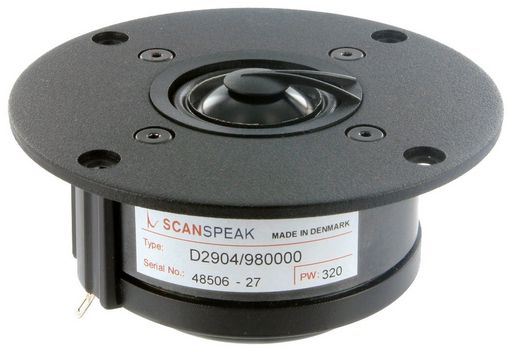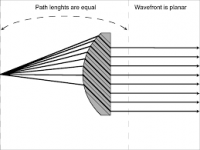Hi Charles!
I take your point about the wavelength in relation to the gap and have looked into the matter further. My further research reveals that the path length refractor uses plates with spacing that is small compared to the wavelengths in question.
It would appear that the path length refractor deals with higher frequency sound as rays which will travel in straight lines, while it deals with lower frequency sound as waves.
However, by your own admission, diffraction is not the mechanism by which the path length refractor functions.
Re your P.S. In the obstacle array type acoustical lens there are no slanted plates if that is what you mean by 'metal parts'. The obstacles can be spheres, discs, strips, irregular shapes or even pieces of foam as long as they are small in relation to the frequencies involved. The region containing the obstacles slows the sound as it passes through. This region smacks of an inhomogeneous medium to me, but I may be wrong!
I take your point about the wavelength in relation to the gap and have looked into the matter further. My further research reveals that the path length refractor uses plates with spacing that is small compared to the wavelengths in question.
It would appear that the path length refractor deals with higher frequency sound as rays which will travel in straight lines, while it deals with lower frequency sound as waves.
However, by your own admission, diffraction is not the mechanism by which the path length refractor functions.
Re your P.S. In the obstacle array type acoustical lens there are no slanted plates if that is what you mean by 'metal parts'. The obstacles can be spheres, discs, strips, irregular shapes or even pieces of foam as long as they are small in relation to the frequencies involved. The region containing the obstacles slows the sound as it passes through. This region smacks of an inhomogeneous medium to me, but I may be wrong!
Diffraction is also used to widen Tweeter dispersion.
In this case, sound out of a large dome is carried along a path/waveguide towards a narrow vertical slit.
Soundwaves emerging from it get diffracted into a wide horizontal field, since slit width is small compared to wavelength, and at the same time since slit length is large compared to wavelength it gets narrowed in the vertical field.
Practical and best known example:

FWIW narrow slits are used in Optics to explain diffraction, and are very good "dispersion improvers", in this case turning flat front waves into almost perfect "point sources" which in due time allow for very clear results interference experiments:

This is the classic Young´s interference experiment.
EDIT: sometimes you want to widen high frequency dispersion in all planes, not just horizontal or vertical.
In that case you need a narrow mouth horn, circular, and only for highest frequencies, since a very small horn restricts "lower" frequencies.
So this has been applied to very high power PA type Supertweeters.
The king of Stadium size supertweeters for many years was the mighty Yamaha JA4281 , which applies all I mention above:

.JPG)
In this case, sound out of a large dome is carried along a path/waveguide towards a narrow vertical slit.
Soundwaves emerging from it get diffracted into a wide horizontal field, since slit width is small compared to wavelength, and at the same time since slit length is large compared to wavelength it gets narrowed in the vertical field.
Practical and best known example:

FWIW narrow slits are used in Optics to explain diffraction, and are very good "dispersion improvers", in this case turning flat front waves into almost perfect "point sources" which in due time allow for very clear results interference experiments:

This is the classic Young´s interference experiment.
EDIT: sometimes you want to widen high frequency dispersion in all planes, not just horizontal or vertical.
In that case you need a narrow mouth horn, circular, and only for highest frequencies, since a very small horn restricts "lower" frequencies.
So this has been applied to very high power PA type Supertweeters.
The king of Stadium size supertweeters for many years was the mighty Yamaha JA4281 , which applies all I mention above:

Last edited:
The cap as shown on the image is not a diffuser, but actually beams the top octave forward. The way the on-axis response does not droop at the top octave. It is called a phase shield or phase plate. So it does the opposite of the acoustic lens from post #1.diffusers? they work the same not?
Last edited:
Interesting facts about different types of tweeter guys! Good to explore the physics of the different mechanisms by which they operate. 
Returning to the 'slant plate' or 'path length refractor' type of acoustical lens, emosms may have to seek further information before designing his converging acoustical lens.
Apparently, the pattern control technique is the same as that employed with microwaves for creating unidirectional, planar wavefronts. (The wavelengths of high frequency sound waves in air are comparable to the wavelengths of microwave radiation.)
At the high frequencies involved, the acoustical lens operates on the 'ray model' where the sound passes out of the lens in straight lines. Diffraction will occur at the openings of the lens slits, but only with lower frequencies for which the lens is not designed.
Any experts in the field of microwave communications out there?
Returning to the 'slant plate' or 'path length refractor' type of acoustical lens, emosms may have to seek further information before designing his converging acoustical lens.
Apparently, the pattern control technique is the same as that employed with microwaves for creating unidirectional, planar wavefronts. (The wavelengths of high frequency sound waves in air are comparable to the wavelengths of microwave radiation.)
At the high frequencies involved, the acoustical lens operates on the 'ray model' where the sound passes out of the lens in straight lines. Diffraction will occur at the openings of the lens slits, but only with lower frequencies for which the lens is not designed.
Any experts in the field of microwave communications out there?
Attachments
- Status
- This old topic is closed. If you want to reopen this topic, contact a moderator using the "Report Post" button.


